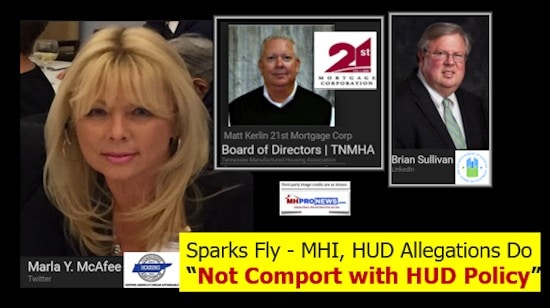
From Justice.gov, is “CHAPTER 5 : ANTITRUST ISSUES IN THE TYING AND BUNDLING OF INTELLECTUAL PROPERTY RIGHTS.”

Bliss is one of several ‘popular’ state executive directors, who stepped up and defended the Manufactured Housing Institute (MHI) in message exchanges with MHProNews.
MHI has referred to state association as ‘affiliates.’ So Bliss can be seen as acting as a surrogate or ‘mouthpiece’ of MHI.
The topic is the Ducker Worldwide report, and possible anti-trust issues. MHI was supposed to make the plan public to the industry, but that presentation was cancelled at Louisville in January, as the Daily Business News previously reported.
MHProNews has repeatedly raised concerns about this issue, as potentially harmful to small to mid size companies, as well as to potentially millions of manufactured home owners.
Secretive “NEW” Class of Manufactured Housing Raises Serious Concerns
To date, MHI has not refuted – or even tried to refute – those concerns, though they’ve been given a number of opportunities to do so.
MHProNews replied in part to Bliss’ message saying “FYI, my [MHProNews publisher’s] dues money helped pay for that [Ducker] research, and they still didn’t give it to me, why?”
But there are several issues that Bliss – apparently acting as an MHI surrogate – uncovered another point that points to concerns about anti-trust issues at the Arlington, VA based association.
In essence, intentionally or not, Bliss confirmed questions put to MHI leadership. That will be part of a follow up and related report planned for Saturday, unless a hotter news item hits before.


What WHA’s Bliss Messages Point to is Known as “Tying and Bundling,” Which can be Illegal
What follows below is verbatim from the DOJ website, Chapter 5, cited above.
Bold or red text is used below by the Daily Business News to underscore potentially salient point and provide comments, with respect to what WHA – an MHI ‘affiliate’ – and thus apparent surrogate Bliss – said with respect to MHI and their Ducker ‘research.’
Note too, while MHProNews is not offering legal advice or opinions, in insuring with an attorney about this topic today, it was confirmed that this could indeed be an example of tying in a manner that is prohibited by anti-trust laws.
Here is part of the message that an attorney sent to the Daily Business News with respect to this issue, “A tie-in is used to create an illegitimate link between a popular product and an unpopular one. In this case, tying access to the new class of home to mhi membership, thereby forcing a customer of one to also “buy” the other.”
Isn’t that what Bliss – again MHI describes the WHA as an ‘affiliate,’ plausibly described what MHI is doing?
- Namely, tying to get small to mid sized companies being a member to getting this report?
- A report that MHI has indicated will be used to influence public policy, and potentially HUD regulators?
- And thus it can seen as being a monopolistic influence on the proposed market?
- And what are the implications for millions of manufactured home owners values?
The anti-trust and consumer concerns seem real.
These concerns ought to be carefully considered by any and every MHI member, but particularly those who are involved in membership (state associations), or stockholder organizations.
It is MHProNews’ understanding that liability could be created through this anti-trust clouded concept, per the legal opinion previously noted.
More specifics are found below, from the DOJ website.

INTRODUCTION
“Tying and bundling [are] so ubiquitous that we forget they are there . . . . Tying and bundling [are], roughly speaking, what the modern firm does. It’s the rationale. It puts things together and offers them in packages to consumers.”(1)
A tying arrangement occurs when, through a contractual or technological requirement, a seller conditions the sale or lease of one product or service on the customer’s agreement to take a second product or service.(2) The term “tying” is most often used by economists when the proportion in which the customer purchases the two products is not fixed or specified at the time of purchase, as in a “requirements tie-in” sale.(3) A bundled sale typically refers to a sale in which the products are sold only in fixed proportions (e.g., one pair of shoes and one pair of shoe laces or a newspaper, which can be viewed as a bundle of sections, some of which may not be read at all by the customers). Bundling may also be referred to as a “package tie-in.”(4) Case law in the United States sometimes uses the terms “tying” and “bundling” interchangeably.(5)
In view of their potential efficiencies, many economists believe that, in general, tying and bundling are more likely to be procompetitive than anticompetitive.(6) Analysis of the anticompetitive effects of tying and bundling by U.S. courts, by contrast, has evolved over time. Although courts long have expressed concern that tying or bundling might enable firms to use monopoly power in one market as leverage to curb competition, and thereby acquire monopoly power, in a second market,(7) judicial concern has eased as tying and bundling have become better understood. Once thought to be worthy of per se condemnation(8) without examination of any actual competitive effects, tying currently is deemed per se illegal under U.S. Supreme Court rulings only if specific conditions are met, including proof that the defendant has market power over the tying product.(9) Further, the Supreme Court has recently recognized that competitive markets and tying arrangements are not incompatible.(10) Indeed, some lower courts have required proof of likely or actual anticompetitive effects and efficiencies in tying cases.(11)
(MHProNews Note: Isn’t this precisely what Bliss/MHI are suggesting?)
At the Hearings, one panel discussed how the Agencies and the courts could best analyze tying and bundling when two or more products are tied or bundled together and at least one of the products is protected by intellectual property rights. Panelists discussed how to reach the right answers in particular cases and how to give private parties a reasonable ability to predict how their intellectual property licensing practices will be treated under the antitrust laws.(12) As discussed below, panelists generally doubted that tying and bundling involving intellectual property are likely enough to harm consumer welfare to justify per se treatment, and therefore advocated a rule of reason approach that would require proof of likely or actual anticompetitive effects and allow consideration of the efficiencies that such arrangements may generate.(13)
- LEGAL ANALYSES OF TYING AND BUNDLING(14)
Ever since the late 1940s, when the Supreme Court stated in International Salt Co. v. United States that “it is unreasonable, per se, to foreclose competitors from any substantial market,“(15) and in Standard Oil Co. v. United States that “[t]ying agreements serve hardly any purpose beyond the suppression of competition,”(16) U.S. courts have found tying to be per se unlawful.(17) Although the Court’s 1984 Jefferson Parish opinion confirmed the continued role of a per se analysis,(18) it emphasized that market power in the tying product was a requirement for per se illegality.(19) Later that same year, the Court explained that the application of the per se rule to tying had evolved to incorporate a market analysis:
[T]here is often no bright line separating per se from Rule of Reason analysis. Per se rules may require considerable inquiry into market conditions before the evidence justifies a presumption of anticompetitive conduct. For example, while the Court has spoken of a “per se” rule against tying arrangements, it has also recognized that tying may have procompetitive justifications that make it inappropriate to condemn without considerable market analysis.(20)
Consistent with this approach, the Supreme Court recently acknowledged that “[m]any tying arrangements . . . are fully consistent with a free, competitive market.”(21) Indeed, leading treatises have commented that the test lower courts use to determine whether to apply the per se rule to a particular alleged tie “increasingly resembles a rule of reason inquiry.”(22)Although the elements of a per se tying violation have been articulated differently, courts generally require that:
(1) two separate products or services are involved, (2) the sale or agreement to sell one is conditioned on the purchase of the other, (3) the seller has sufficient economic power in the market for the tying product to enable it to restrain trade in the market for the tied product, and (4) a not insubstantial amount of interstate commerce in the tied product is affected.(23)
(MHProNews Note: Again, isn’t this what Bliss/MHI are suggesting?)
For other per se violations, such as naked agreements to fix price, plaintiffs are not required to define the relevant product markets or show that the defendant has market power in a relevant market. In addition, some courts have shown a willingness to consider business justifications for the alleged tie,(24) and some courts have required proof that the tie has anticompetitive effects.(25)
Courts have sometimes analyzed bundling under the rubric of tying. In United States v. Loew’s, Inc.,(26) for example, the Supreme Court found that the practice of licensing feature films to television stations only in blocks (or “bundles”) containing films the stations did not want to license constituted unlawful tying in violation of section 1 of the Sherman Act.(27)Nonetheless, in explaining its tying analysis in Jefferson Parish, the Supreme Court noted the fact that “a purchaser is ‘forced’ to buy a product he would not have otherwise bought even from another seller” does not imply an “adverse impact on competition.”(28) Thus, to prevail on an unlawful tying claim, a plaintiff would have to show an exclusionary effect on other sellers as a result of plaintiff’s thwarted desire to purchase substitutes for one or more items in the bundle from other sources that harms competition.
III. TYING AND BUNDLING INVOLVING INTELLECTUAL PROPERTY
Linking intellectual property with products or other intellectual property can take many forms, such as offering licenses that cover multiple patents or copyrighted materials or tying the sale of two patented goods or one unpatented and one patented good. Such linkages carry various labels, depending on whether the linked product embodies intellectual property, whether one price or separate prices are charged, and whether the linkage is accomplished contractually or technologically. Classic “contractual” patent tying occurs when the tying product (such as a mimeograph machine) is patented, the tied product is an unpatented commodity used as an input for the tying product (such as ink or paper), and the sale of the patented product is conditioned on the purchase of the unpatented product. A “technological tie” may be defined as one in which “the tying and tied products are bundled together physically or produced in such a way that they are compatible only with each other.”(29) The government’s tying claim against Microsoft involved both the contractual and technological bundling of the Internet Explorer web browser (the tied product) with its Windows operating system (the tying product).(30)
Multiple intellectual property rights may themselves be combined into bundles or packages. Mandatory package licensing occurs when a patent owner refuses to license a particular patent unless a licensee accepts an entire package (or where the patent owner’s royalty scale has this effect).(31) It also includes “block booking” of motion pictures or television shows. Panelists explored the economic, legal, and practical issues raised by these various practices, all of which involve intellectual property tying or bundling.
- The Economics of Bundling Involving Intellectual Property
Economists on the panel discussed features that may distinguish intellectual property from tangible property. One such feature is that the development and exploitation of intellectual property typically involves high fixed costs but low marginal costs, but the panel discussion did not make the relevance of this distinction to the analysis of bundling clear. One panelist suggested that predicting anticompetitive effects may be more difficult in cases involving intellectual property bundling than in cases involving the bundling of tangible property.(32)Another panelist stated that it is difficult to determine whether intellectual property bundling in a particular case is driven by efficiencies and, as a result, the analysis is ultimately fact-intensive.(33)
Two economists have considered the bundling of so-called information goods, such as copyrighted music, programming, and other online content on the Internet.(34) They observe that the marginal cost of adding additional units of an information good to a bundle of other information goods typically is very low. They also observe that demand for bundles of goods across customers can be more homogeneous than the demand for the individual components. In such circumstances, it can be more profitable to offer such goods only in a bundle. In their analysis, competition between two firms that each offer sufficiently large bundles can make consumers better off,(35) and bundling by a firm facing no competition can increase total welfare but increase or decrease consumer welfare.(36)
Another distinction between intellectual and tangible property is that the validity of patents can be challenged. It is widely believed that intellectual property bundling “is apt to affect private incentives to challenge the IP”(37) –most likely decreasing incentives to challenge it. Some find it difficult to assess the likely welfare effects of this decrease, however, because the optimal level of incentive to challenge intellectual property rights is not clearly known.(38)
- Legal Issues Relevant to Intellectual Property Bundling
Courts have not taken a consistent analytical approach to tying and bundling cases involving intellectual property. In 1999, the U.S. Court of Appeals for the Eleventh Circuit applied the per se rule to a package license for television programming because the package at issue could not be distinguished from the block booking that the Supreme Court declared to be illegal per se in Loew’s.(39)
By contrast, the U.S. Court of Appeals for the D.C. Circuit’s 2001 decision in United States v. Microsoft rejected application of the per se rule to “platform software,”(40) thereby “carving out what might be called a ‘technology exception’ to that rule,”(41) as one submission suggested. The court reasoned that application of traditional per se analysis in the “pervasively innovative” platform software industry risks condemning ties that may be welfare-enhancing and procompetitive.(42) According to one panelist, however, “the rationale [that the court] articulated for abandoning per se condemnation applies well beyond just the software industry,” notwithstanding “the court’s protestations to the contrary.”(43) Although in Illinois Tool Works Inc. v. Independent Ink, Inc. the Supreme Court recognized that many tying arrangements, “even those involving patents and requirements ties,” can be procompetitive,(44) that case did not present a vehicle for the Court to revisit its conclusion that some tying arrangements constitute per se violations.(45)
The Agencies’ rule of reason approach to intellectual property bundling is reflected in the Antitrust Guidelines for the Licensing of Intellectual Property (“Antitrust-IP Guidelines”). The Antitrust-IP Guidelines recognize that “[c]onditioning the ability of a licensee to license one or more items of intellectual property on the licensee’s purchase of another item of intellectual property or a good or a service has been held in some cases to constitute illegal tying,”(46) but also state that “[a]lthough tying arrangements may result in anticompetitive effects, such arrangements can . . . result in significant efficiencies and procompetitive benefits.”(47) Pursuant to the Antitrust-IP Guidelines, the Agencies, as a matter of prosecutorial discretion, consider both the anticompetitive effects and the efficiencies attributable to a tie. The Agencies would be likely to challenge a tying arrangement if: “(1) the seller has market power in the tying product, [which the Agencies will not presume necessarily to be conferred by a patent, copyright, or trade secret]; (2) the arrangement has an adverse effect on competition in the relevant market for the tied product; and (3) efficiency justifications for the arrangement do not outweigh the anticompetitive effects.”(48) If a package license constitutes tying,(49) the Agencies will evaluate it pursuant to the same rule of reason principles they use to analyze other tying arrangements.
Whether the legal analysis applied to intellectual property bundling is some form of the per se rule or the more searching rule of reason, a plaintiff will have to establish that a defendant has market power in the tying product. Recognizing that “Congress, the antitrust enforcement agencies, and most economists have all reached the conclusion that a patent does not necessarily confer market power upon the patentee,” the Supreme Court has held that “in all cases involving a tying arrangement, the plaintiff must prove that the defendant has market power in the tying product.”(50) Thus, market power should not be presumed merely from the existence of a patent.(51) As the Court explained:
[W]e conclude that tying arrangements involving patented products should be evaluated under the standards applied in cases like Fortner II and Jefferson Parish rather than under the per se rule applied in Morton Salt and Loew’s. While some such arrangements are still unlawful, such as those that are the product of a true monopoly or a market wide conspiracy, that conclusion must be supported by proof of power in the relevant market rather than by a mere presumption thereof.(52)
The Agencies, as a matter of sound economics, had chosen not to rely on such a presumption prior to Illinois Tool.(53) As the Antitrust-IP Guidelines explain, the Agencies “will not presume that a patent, copyright, or trade secret necessarily confers market power upon its owner. Although the intellectual property right confers the power to exclude with respect to the specific product, process, or work in question, there will often be sufficient actual or potential close substitutes . . . to prevent the exercise of market power.”(54) The Agencies therefore investigate the relevant market to determine whether the intellectual property at issue grants any market power in the economic sense. If such market power is found, the Agencies further investigate whether the business practice under scrutiny is likely to be anticompetitive on balance.
- Practical Issues Regarding Intellectual Property Bundling
Panelists addressed several issues that attorneys confront when counseling clients with regard to intellectual property bundling. One panelist noted that, in addition to the courts’ inconsistent treatment of cases involving intellectual property bundling, courts have also differed in ordinary tying cases as to whether: (1) a plaintiff must show harm to competition in the tied product market; and (2) a defendant’s evidence of business justification is admissible.(55) “The result of this is when the client asks you about what the rules are governing bundling of intellectual property . . . you cannot give a clear answer. [Lawyers have to give] the cautious advice . . . please, don’t do it; the risk [of litigation] is too great.“(56)
(MHProNews Note: Doesn’t this goes to the heart
of issues raised by the Daily Business News for companies with stockholders,
or organization’s with members, in the linked article, below?)
Fiduciary Responsibility to Corp Shareholders-MH Anti-Trust Concerns; Plus MH Market UPdate$
The panel also discussed the extent to which attorneys counseling their clients will consider the likelihood that an enforcement agency or private party will challenge intellectual property bundling.(57) Due in part to the rules on antitrust injury and standing, the probability of being sued may be small, but one panelist expressed the view that, “given the state of the law today you just can’t advise a client that has an intellectual property right that it’s okay to tie . . . . It’s just too dangerous.”(58) Counseling about potential antitrust liability also occurs when a client is about to bring an infringement suit, because such a suit may trigger an antitrust counterclaim even when an antitrust suit would otherwise be unlikely. One panelist expressed the view that “it’s per se malpractice to fail to advise a client who is considering an intellectual property infringement suit that he must be prepared to litigate any manner of crazy antitrust or misuse counterclaim — or misuse defense.”(59)
Another panelist observed that firms that have been advised by counsel will often offer alternatives to a package license. He suggested that “one way to [offer] package licenses and not get immediately hauled into [f]ederal [d]istrict [c]ourt is to make sure there’s an alternative available.”(60) When another panelist questioned the wisdom of advising clients “that they are essentially home free on bundling pricing where intellectual property is involved,”(61) the other replied that, although this practice does not provide a complete safety zone, “the difficulty of proving that the pricing bundle is sufficiently coercive . . . given the expense of bringing an antitrust case . . . gives you a measure of comfort . . . .”(62)
Finally, one panelist argued that, although defendants in many cases could “devise ways of achieving the same efficiencies without tying,”(63) the per se rule creates “enormous cost in terms of firms without market power and with intellectual property rights trying to figure out the best way to exploit those rights,” such as small firms trying to enter a market in which metering through tying may work best.(64) Another panelist suggested that “product combination decisions[,] like things that can be characterized as ties[,] ought to be presumptively lawful” and that the real problem with the per se rule against tying is that it is “potentially applicable to an enormous range of harmless commercial decisions which nevertheless tend to attract involvement with law enforcement and the civil justice system.”(65)
- Suggested Approaches to Improving the Law on Intellectual Property Bundling
The panel explored ways to improve the law on tying in general and with regard to intellectual property bundling in particular. One panelist highlighted three approaches.(66) First, he suggested that the courts, instead of carving out exceptions to the per se rule against tying (as the D.C. Circuit did for “platform software” products in Microsoft(67)), should follow the approach taken by the U.S. Court of Appeals for the Seventh Circuit in Khan v. State Oil Co.,(68)which applied the per se rule against vertical maximum price-fixing while carefully explaining the shortcomings of the approach and inviting the Supreme Court to overturn it, as the Court ultimately did.(69) Second, testifying prior to Illinois Tool, he suggested that Congress should consider legislation mandating that there shall be no presumption of market power from the mere possession of a patent or copyright in antitrust cases.(70) Third, he suggested that the Agencies should advocate improvements in the law through amicus participation in cases involving intellectual property bundling, both in the district courts and courts of appeals, with the hope that the decisions of these courts may eventually be reviewed by the Supreme Court.(71)
Panelists acknowledged that conducting a rule of reason analysis of intellectual property bundling or other practices results in a very fact-intensive inquiry, the outcome of which will likely be difficult to predict.(72) An economist on the panel suggested that, rather than attempting to categorize the conduct (e.g., as tying or not) or looking at cost standards, a better approach would be “to ask why are you doing this; what are the efficiencies, are there other ways to achieve the efficiencies; do you expect it to block competition[?]”(73)
- CONCLUSION
Legal and policy analysis of intellectual property bundling has evolved over time. Older case law, with its per se rule and presumption of market power, contends with the current analysis of the Agencies and some more recent lower court decisions that embody, in essence, a rule of reason approach. Moreover, the Supreme Court recently eliminated its rule presuming market power based on intellectual property. Panelists noted that, although intellectual property bundling may have anticompetitive potential in certain circumstances, there may also be significant efficiency justifications for such bundling in some cases. Thus, as a matter of their prosecutorial discretion, the Agencies will apply the rule of reason when evaluating intellectual property tying and bundling agreements.(74) Given the ubiquitous use of these arrangements by businesses lacking in market power and the efficiencies that such arrangements can often entail, these practices usually are not anticompetitive. When the Agencies do identify anticompetitive situations, however, they will pursue them.
Footnotes:
MHProNews is providing only the following footnote, as being of particular interest to industry readers.
- Business practices merit treatment as per se illegal if “their pernicious effect on competition and lack of any redeeming virtue are conclusively presumed to be unreasonable.”N. Pac. Ry., 356 U.S. at 5.
The entire DOJ content with footnotes can be found at this link.
“We Provide, You Decide.” © ## (News, analysis, and commentary.)
Related:
Progressive “Nation” Reports on Monopolies Cites Buffett, Clayton, Others – MH Industry Impact?


Sign Up Today! Click here to sign up in 5 seconds for the manufactured home industry’s leading – and still growing – emailed headline news updates. You’ll see in the first issue or two why big, medium and ‘mom-and-pop’ professionals are reading these headline news items by the thousands. These are typically delivered twice weekly to your in box.
(Third party images, and cites are provided under fair use guidelines.)
Follow us on Twitter:
ManufacturedHomes
@mhmsmcom

Soheyla is a managing member of LifeStyle Factory Homes, LLC, the parent company to MHProNews, and MHLivingNews.com.

